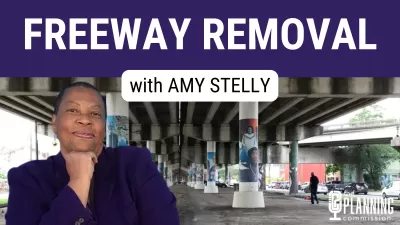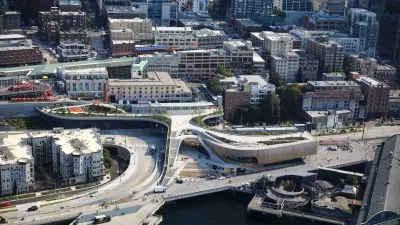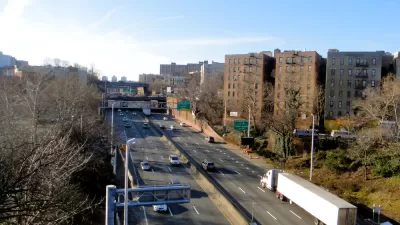Amy Stelly’s childhood dream was to remove the highway that devastated her neighborhood. Now that those efforts have gained traction, institutional biases remain as much of a barrier to neighborhood healing as the highway itself.

The topic of highway teardowns seems like a new conversation in planning circles. However, for architect-turned-planner-turned-advocate Amy Stelly, the removal of New Orleans’ I-10 Claiborne Expressway has been a lifelong dream.
“I just decided a kid that I didn’t like it,” Stelly told the Planning Commission Podcast about growing up in its shadows. “I remember promising myself that when I grew up and learned enough to take it down, I would just do it.”
The I-10 route through New Orleans bisected Stelly’s childhood neighborhood as way to facilitate the fast movement of motorists to the French Quarter. The wide boulevards that typify New Orleans, with medians known as Neutral Grounds, made avenues that ran through the City’s black neighborhoods easy targets for freeway construction. In 2021, the Claiborne Expressway was named one of the 15 “Worst Highways in America.”
“When they get off [the freeway], they to go to the French Quarter, they don’t stop,” said Stelly. “The highway is built so close to the houses that it looks like the deck is sitting on the roof of some. It’s terrible.”
Stelly’s efforts to remove the highway began in earnest in 2017, five years after she returned to her childhood home after working in Florida. She tells The Planning Commission Podcast of the early days, when neighbors would tell her the highway’s removal would never happen: “We’re stuck with it, we have to live with it.”
Stelly says this is an indicator of “the apathy that comes with having to live in a very depressed and oppressive environment,” the result of long-standing sociological effects of having to live with highways in your backyard.
Modern-day hopes come in the form of a planning grant from USDOT to study the freeway’s removal, as well as Stelly’s efforts to work with schoolchildren to measure the health impacts of the existing roadway.
As one would expect, resistance from state transportation officials and a fear of retaliation still stand in the way of neighborhood healing. Stelly addresses these challenges to achieving her childhood dream as the episode progresses.
The Planning Commission is a spirited debate by planners, for planners. This independent outlet for all things planning explores the serious and lighter sides of the profession, poses probing and creative questions to guests, and always pairs the episode guest and topic with a choice libation. Listen to the podcast for a special offer from Planetizen.
FULL STORY: The Planning Commission Podcast - Season 2, Episode 13; or find it on your favorite podcast app!

Manufactured Crisis: Losing the Nation’s Largest Source of Unsubsidized Affordable Housing
Manufactured housing communities have long been an affordable housing option for millions of people living in the U.S., but that affordability is disappearing rapidly. How did we get here?

Americans May Be Stuck — But Why?
Americans are moving a lot less than they once did, and that is a problem. While Yoni Applebaum, in his highly-publicized article Stuck, gets the reasons badly wrong, it's still important to ask: why are we moving so much less than before?

Using Old Oil and Gas Wells for Green Energy Storage
Penn State researchers have found that repurposing abandoned oil and gas wells for geothermal-assisted compressed-air energy storage can boost efficiency, reduce environmental risks, and support clean energy and job transitions.

Updating LA’s Tree Rules Could Bring More Shade to Underserved Neighborhoods
A new USC study finds that relaxing Los Angeles’ outdated tree planting guidelines could significantly expand urban tree canopy and reduce shade disparities in lower-income neighborhoods, though infrastructure investments are also needed.

California's Canal Solar Projects Aim to Conserve Resources and Expand Clean Energy
California’s Project Nexus has begun generating electricity from solar panels installed over irrigation canals, with researchers and state agencies exploring statewide expansion to conserve water and boost clean energy production.

HHS Staff Cuts Gut Energy Assistance Program
The full staff of a federal program that distributes heating and cooling assistance for low-income families was laid off, jeopardizing the program’s operations.
Urban Design for Planners 1: Software Tools
This six-course series explores essential urban design concepts using open source software and equips planners with the tools they need to participate fully in the urban design process.
Planning for Universal Design
Learn the tools for implementing Universal Design in planning regulations.
Heyer Gruel & Associates PA
City of Moreno Valley
Institute for Housing and Urban Development Studies (IHS)
City of Grandview
Harvard GSD Executive Education
Salt Lake City
NYU Wagner Graduate School of Public Service
City of Cambridge, Maryland





























